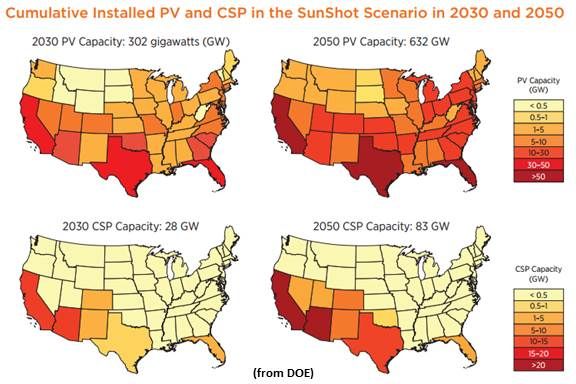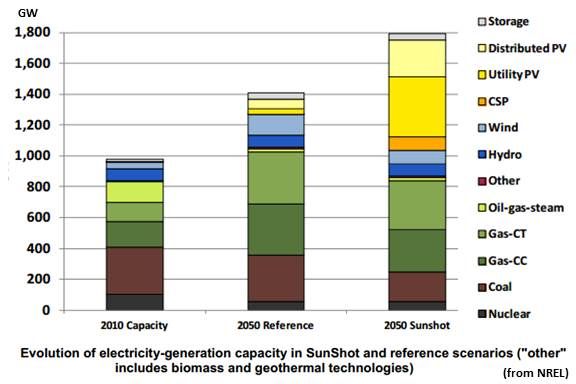A new $60 million investment into the SunShot Program by the U.S. Department of Energy will extend the federal government’s commitment to bringing solar costs down.
“Over the last three years, the cost of a solar energy system has dropped by more than 70 percent,” DOE Secretary Ernest Moniz said in announcing the awards. The new investments will back more programs that reduce “soft costs like permitting, installation and interconnection” and “improve hardware performance and efficiency.”
The SunShot Program, initiated by the DOE in 2007, has leveraged $104 million in federal money to generate more than $1.7 billion in private sector investment. It has incubated the emergence of 58 U.S. startups. That is, according to the DOE, almost $18 of private sector buy-in for every dollar of taxpayer support.
The long-term SunShot vision is for the U.S. to get 14 percent of its electricity from the sun by 2030 and 27 percent by 2050.

More than $12 million of the new federal investment was awarded to support seventeen companies working to get their technologies and services across the Valley of Death that separates concept and commercialization, including:
- Applied Novel Devices, Inc. ($500,000): A design and manufacturing process that reduces the cost of high-efficiency Si solar cells
- Brittmore Group, LLC ($684,708): An automated system for pre-assembling PV modules and deploying them robotically
- Clean Power Research ($945,529): Software to cut the soft costs of interconnecting DG
- Demeter Power ($500,000): Solar leasing through property-tax-bill assessment
- EnergySage ($1,250,000: Online shopping for PV installation
- Folsom Labs ($350,000): Software for designing solar arrays
- Geostellar ($750,000): Streamlined online procurement, financing, installation, and maintenance of solar
- Infinite Invention ($500,000): A socket for simplified connection of a solar PV system to the electric meter
- kWh Analytics ($450,000): Big-data information tools for risk management of solar investment
- Renewable Power Conversion ($994,378): More durable “macro-micro” inverters
- Silicon Solar Solutions ($500,000): Improved efficiency of n-type solar cells
- Simply Civic ($400,000): Online application for permitting to jurisdictions across the country
- Sinewatts ($499,735): Miniaturization of PV power electronics
- SMASHsolar ($500,000): Easy-install PV mounting systems
- Solar Census ($735,072): Online solar array design for streamlined cost-quoting
- Sun Number ($1,000,000): A tool for more effective solar array siting
- Sunrun ($1,600,000): Online solar project automatic design, costing, simulation, proposal generation, pricing, permitting, and field change management
Another $16 million went to four efforts to advance solar cell efficiency:
- Arizona State University ($3,499,156): Project in collaboration with MIT, Caltech, the University of New South Wales, and the Swiss Federal Institute of Technology
- Georgia Institute of Technology ($3,500,000): Project in collaboration with NREL and Fraunhofer ISE
- IBM Thomas J. Watson Research Center ($4,497,657): Project in collaboration with the University of Delaware Institute for Energy Conversion, the University of California in Santa Barbara, and Harvard
- National Renewable Energy Laboratory ($4,500,000): Project in collaboration with First Solar, Texas State University, Colorado State University, the Colorado School of Mines, and Washington State University
Grants totaling $7 million were provided to improve solar PV and CSP systems and power electronics. Recipients included:
- Arizona State University ($1,417,100): For the study of CdTe thin-film PV
- GE Global Research ($1,933,138): For GE research into a supercritical CO2 turbine
- National Renewable Energy Laboratory ($1,556,250): For the study of CSP advanced materials’ and coatings’ degradation/failure mechanisms
- Sandia National Laboratories ($1,387,500): For the study of power electronics reliability standards
- Stanford University ($1,165,500): For the study of CPV technologies’ reliability and durability

Eight awards, totaling $8 million, were invested toward a more seamless integration of renewables into the grid (see GTM Research’s Grid Edge report for more on this topic):
- PEPCO Holdings Inc. ($979,293): To study the impact of solar power plants on grid systems
- AWS Truepower ($391,773): To study the need of bulk power systems with high solar penetration for balancing reserves
- Clean Power Research ($500,000): To improve the accuracy of load forecasting for California’s grid, where distributed solar penetration is high
- Hawaiian Electric Company ($500,000): To compare the performance of the energy management systems on Oahu and Maui where there is high distributed solar penetration and advanced short-term wind and solar forecasting are being used
- University of California, San Diego ($499,900): To study the cost reductions from an already operational real-time dispatch and automatic generation control tool for different levels of solar penetration
- Electricore, Inc. ($420,155): For developing simulation and decision support tools for real-time grid operations
- Electric Power Research Institute ($873,347): For the study of high-penetration-solar future scenarios in the southeastern U.S.
- National Rural Electric Cooperative Association ($3,645,657): For developing standard designs for 0.25-megawatt to 1-megawatt solar projects and for advancing solar in electric cooperatives
Five educational consortia were awarded a total of $15 million to support curriculum development and job training for the “next generation of energy engineers, system operators and utility professionals.” Recipients included:
- Electric Power Research Institute ($4,798,035): To build a Distributed Technology Training Consortium (DTTC) in the eastern United States
- Electricore, Inc. ($2,700,000): To develop curricula for power systems training
- The Interstate Renewable Energy Council (amount not announced): To build a national framework for power systems training
- Missouri University of Science and Technology ($4,999,976): To create the Mid-America Regional Microgrid Education and Training Consortium
- University of Central Florida ($3,670,000): To upgrade the existing power systems engineering workforce
Finally, $1 million went to Delaware State University and the University of Texas at San Antonio to grow solar energy research and education opportunities for minority students.



